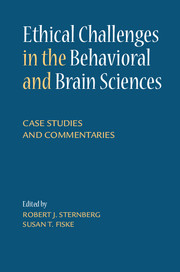Book contents
- Frontmatter
- Contents
- List of Contributors
- Preface
- Part I Academic Cheating
- 1 Beyond the Immediate
- 2 Collaboration, Cheating, or Both?
- 3 Grappling with Student Plagiarism
- 4 Commentary to Part I
- Part II Academic Excuses and Fairness
- Part III Authorship and Credit
- Part IV Confidentiality’s Limits
- Part V Data Analysis, Reporting, and Sharing
- Part VI Designing Research
- Part VII Fabricating Data
- Part VIII Human Subjects
- Part IX Personnel Decisions
- Part X Reviewing and Editing
- Part XI Science for Hire and Conflict of Interest
- Epilogue Why Is Ethical Behavior Challenging?
- Index
4 - Commentary to Part I
Published online by Cambridge University Press: 05 February 2015
- Frontmatter
- Contents
- List of Contributors
- Preface
- Part I Academic Cheating
- 1 Beyond the Immediate
- 2 Collaboration, Cheating, or Both?
- 3 Grappling with Student Plagiarism
- 4 Commentary to Part I
- Part II Academic Excuses and Fairness
- Part III Authorship and Credit
- Part IV Confidentiality’s Limits
- Part V Data Analysis, Reporting, and Sharing
- Part VI Designing Research
- Part VII Fabricating Data
- Part VIII Human Subjects
- Part IX Personnel Decisions
- Part X Reviewing and Editing
- Part XI Science for Hire and Conflict of Interest
- Epilogue Why Is Ethical Behavior Challenging?
- Index
Summary
We are in a new era of academic cheating, but not necessarily because there is more of it. Rather, cheating 2.0 is all about new technology for Big Data, whether searching databases for papers to plagiarize, checking submitted work for plagiarism, or analyzing tests for patterns of performance.
For faculty, catching cheaters is about system-level monitoring to detect patterns. That is, cheater detection is partly about comparing the individual student’s ongoing performance to a sudden, surprising leap in performance, prompting a closer look. Cheater detection on tests in particular is also about comparing two or more students’ performance for a surprising similarity in the errors they make (accurate performance being less diagnostic because it is less idiosyncratic). Likewise, while twenty-first-century technology makes plagiarizing easier, mainly thanks to the Internet, it also makes catching students committing plagiarism easier, for the same reason. Recall that just a couple of decades ago, with only physical library resources available to both students and educators, both plagiarising and catching plagiarisers were time- and effort-consuming tasks.
Faculty do engage in system-level monitoring to detect odd patterns, and new technologies help here. But as this part has shown, deciding how to manage cheating is a more human process, creating a teachable moment for the student, the instructor, and the institution.
- Type
- Chapter
- Information
- Ethical Challenges in the Behavioral and Brain SciencesCase Studies and Commentaries, pp. 11 - 12Publisher: Cambridge University PressPrint publication year: 2015

